Airport Express Dissected!
The Airport Express is a intriguing piece of elegant engineering. Barely larger than a powerbook power supply, it features a wireless access point, a USB port for printers, a ethernet jack, even a digital/analog audio connector, in a package with a built-in power supply that can be plugged right into any wall-jack. This is the wireless access point a lot of people have been dreaming about, for good reason.
Besides being a great way to share a USB printer between several computers (and working great with my Epson C80), it also allows you to hook up your stereo wirelessly to your computer to listen to music. Thus, your computer (and/or server) can be far away yet you can hear what you want to hear, where you want to hear it. Plus, Apple makes hooking the stuff easy enough that even I can do it.
I've been meaning to host these pictures since September 2003, when I took the Express apart. But I've simply been too busy... anyway, I'd shy away from following in my footsteps, as i pretty much destroyed the exterior appearance of the ABS trying to take it apart. Apple took non-servicability to a new high when it decided to weld the exterior case together ultrasonically.
I also would like to extend my thanks to Tom Morris, who e-mailed me with lots of interesting information about the Airport Express. You can see pictures of his Airport Express on his web-site. Thanks to him, we know that the antenna in the Express is a J-pole antenna and that there is an unknown plug to connect to. Thus, it is possible to connect an external antenna to the Express, if you could find the right connector. Considering the amount of effort required to get here, only the hardcore will attempt to do so... and they will probably prefer soldering an antenna wire directly to the traces.
Besides, there is little one can do inside the Express, anyway, as every component is integrated right onto the mother- or daughter-board. There are no more separate transmitter cards, jacks, etc., so there really is no reason to open the Express besides curiousity and the desire to void the warranty as quickly as possible. Click on any image to enlarge it.
 So innocent and pure... |
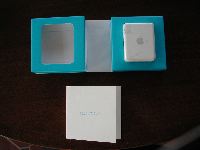 As usual, the packaging by Apple is designed to be as impeccable as the hardware itself. |
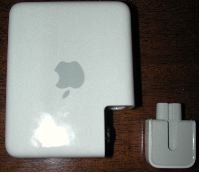 The Airport Express is slightly larger than your average Powerbook power supply. |
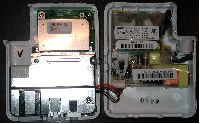 Here, the innards have been split. On the right, the power supply can be seen, on the left, is the low-voltage part of the Express. |
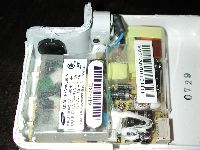 The power supply allows universal input voltages and seems to be encased quite well to prevent interference and short circuits. |
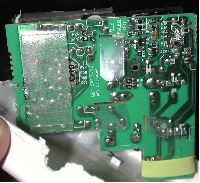 Here is the underside of the Power Supply PCB, showing some fairly fat traces and lots of grounding. |
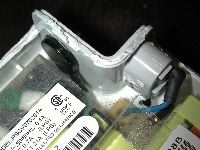 This picture attests to my ham-fisted attempts to get the case open... |
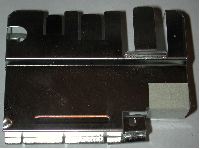 One of the shields over the low-voltage portion of the Express. |
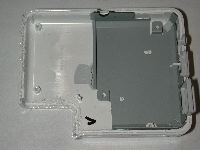 The case below the motherboard. Note the shielding metal insert, which protects the ethernet, etc. portion from interference. To the left, there is no shielding, because that's where the 2.4GHz WiFi transmitter sits. |
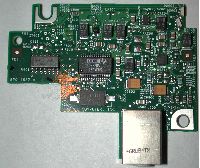 The audio daughtercard. The optical/audio jack is visible in the box at the bottom, all the other components apparently regulate the output of the digital and analog jack. The Burr-Brown PCM2705 handles the Digital to Analog audio conversion and gets its bits via the USB bus (Thanks Tom Morris!). Also note the two LEDs in the top right corner which indicate the status of the ABS. |
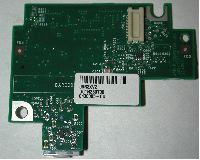 The underside of the audio board shows the daughtercard connector (gray, top right) as well as additional resistors, capacitors, etc. |
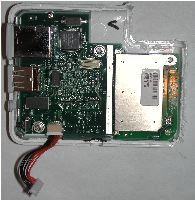 The rest of the Express, after disengaging the power supply, shield, etc. Note how destroyed the external case is at right. Also (barely) visible is the J-pole antenna (bottom right hand of PCB) that allows the Express to work as a WiFi router. |
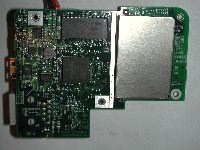 A close-up of the motherboard. The silver portion at right hides the 2.4GHz transmitter hardware, which is built right onto the motherboard. The rectangular cover seems to be soldered to the motherboard, just like all the chips. Presumably, this is done in a second, later solder bath, since the chips under the cover have to be applied to the PCB first. |
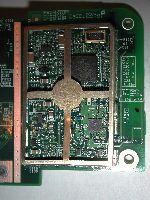 The rectangular cover reveals another shield below and the WiFi chipset. Getting the cover back on (and to stick) was nearly impossible. |
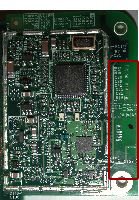 With the second shield removed, the WiFi chipset is visible in all its glory. I have encircled the actual antenna of the Express, which is nothing more than a fat solder trace on the PCB. The Broadcom BCM2050 chip handles the WiFi duties. |
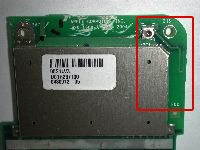 I didn't remove the cover over the Extreme Wifi section on this side of the motherboard because it's soldered even better than on the other side. Maybe later... The antenna is encircled in red, along with some sort of plug (top left). |
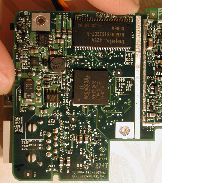 The rest of the board is pretty as well. The chip at the top right is a Hynix DDR memory chip, while the Broadcom BCM4712 chip at center drives the Express. The same chip can be found in a Linksys WRT54G/GS WiFi router (Thanks Tom Morris!). |
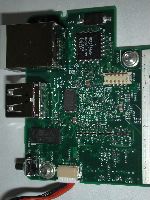 The other side, showing (bottom to top) the power indicator, USB, and ethernet jack. At the top right, the daughtercard connector for the audio portion is visible. The chip ahead of the ethernet jack is likely the one driving it. Towards the bottom is a Atmel Flash memory chip, which presumably holds the settings of the Express when it is turned off. At top, the Broadcom BCM5231 chip handles the USB and Ethernet duties. |
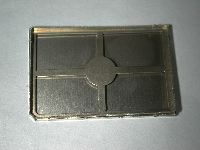 The two covers on top of each other. Presumably, the inner one is shaped the way it is to reduce interference/improve grounding. |
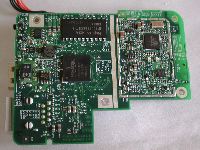 Everything together |
Click on one of the arrows below to be taken to the next Airport Dissection


